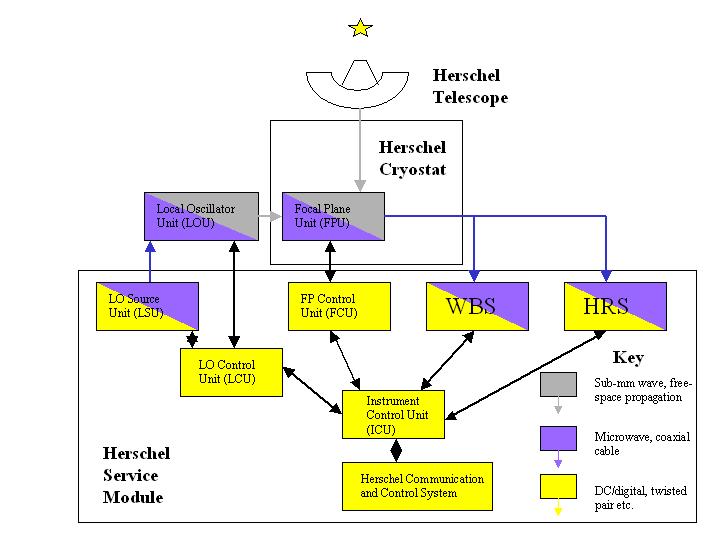Referring to Figure 2.3, “General HIFI component diagram.”, HIFI has five (hardware) sub-systems: the Local Oscillator and Focal Plane Sub- Systems; the Wide-Band and High-Resolution Spectrometers; and the Instrument Control Unit. Within the Local Oscillator Sub-System, a tuneable, spectrally pure 24-36 GHz signal is generated in the Local Oscillator Source Unit. This signal is then frequency-multiplied (upconverted) to 71-106 GHz, amplified, and further frequency-multiplied, by different factors for each of the LO chains, to the desired RF frequency in the Local Oscillator Unit. The result is a spectrally pure LO signal with a tuneable frequency and power level.
Fourteen multiplier chains cover 480-1910 GHz (625 - 157 microns), with two chains for each of the seven Focal Plane Unit mixer channels. The chain feeding the lower frequencies of the band is labelled "a" and for the higher frequencies is labelled "b" (leading to the naming of mixer bands as 1a, 1b, 2a etc.).
The local oscillator beams are fed into the Focal Plane Unit through 7 windows in the Herschel cryostat. Within the Focal Plane Unit, the astronomical signal from the telescope is split into 7 beams. Each of these signal beams is combined with its corresponding LO beam, and then split into 2 linearly polarized beams that are focused into 2 mixer units. Each mixer unit generates an intermediate frequency (IF) signal that is amplified prior to leaving the Focal Plane Unit.
The IF output signals from the Focal Plane Unit can be coupled into two IF spectrometers: the Wide-Band Spectrometer, a four-channel (subband) acousto-optical spectrometer (AOS) that samples the 4-8 GHz band at 1 MHz resolution; and the High-Resolution Spectrometer, a high-speed digital autocorrelator (ACS) that samples narrower portions of the IF band at resolutions up to 140 kHz.
Each of the spectrometers includes a warm control electronics unit. These four control units are, in turn, commanded by a single Instrument Control Unit (ICU), which also interfaces with the satellite's command and control system.
